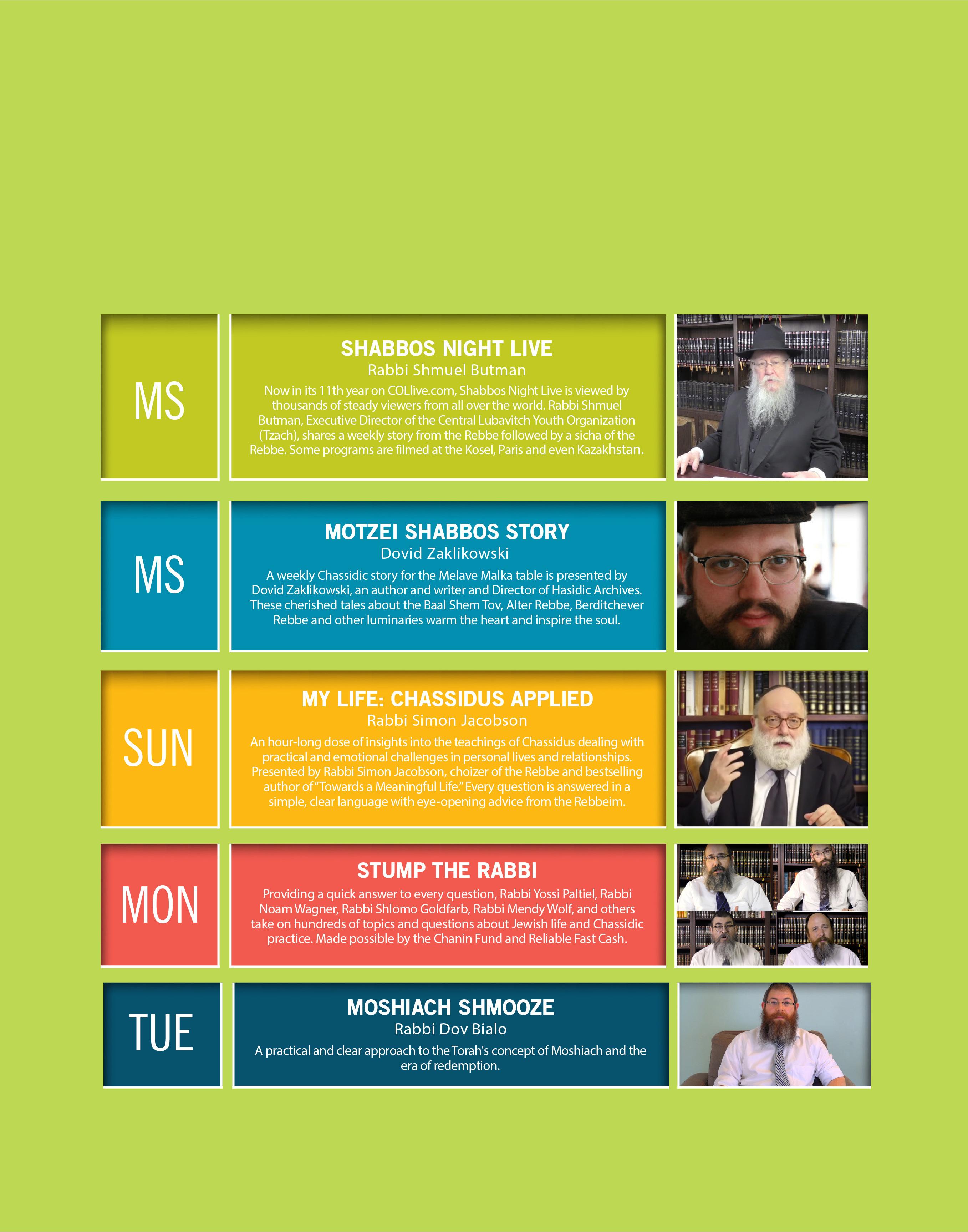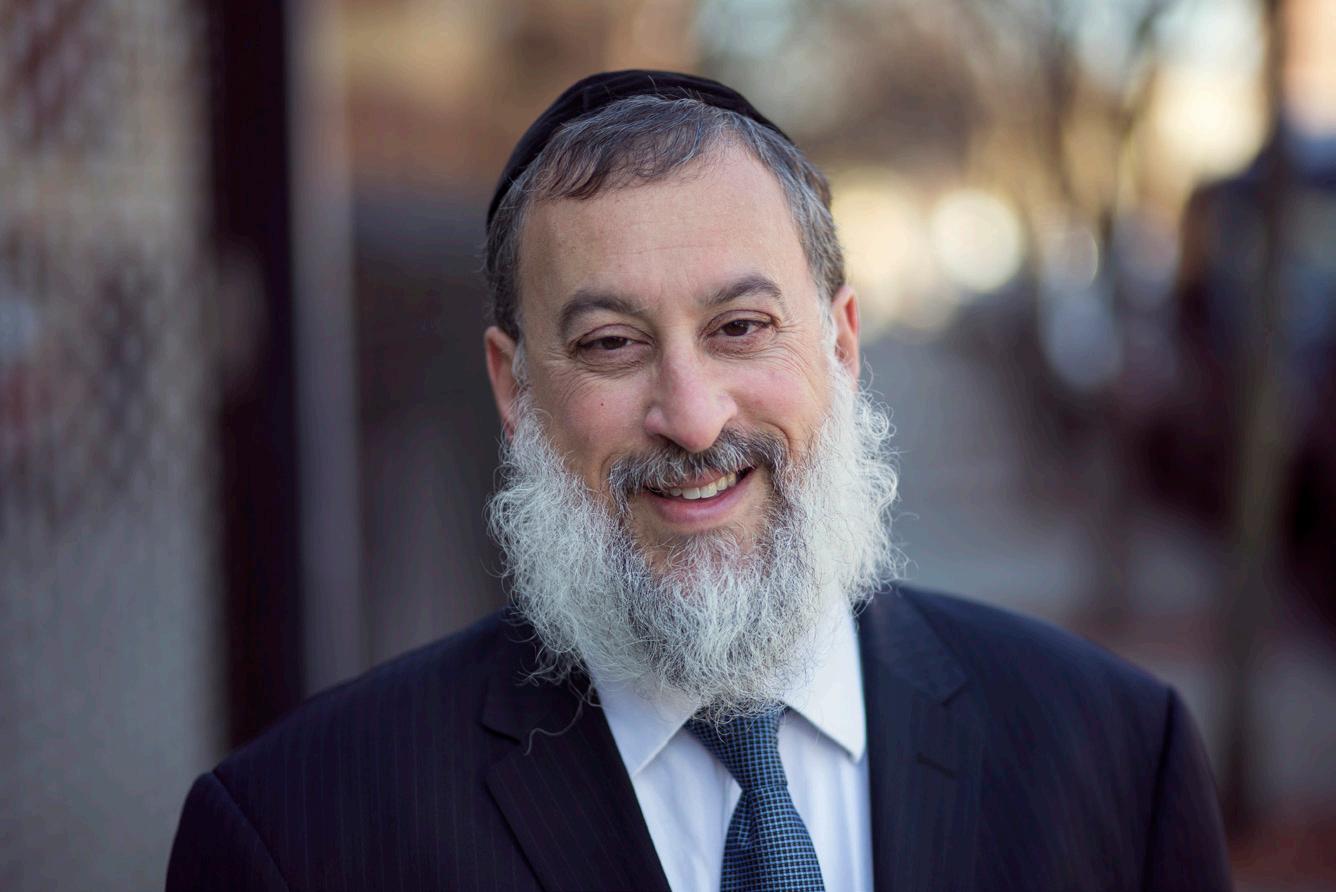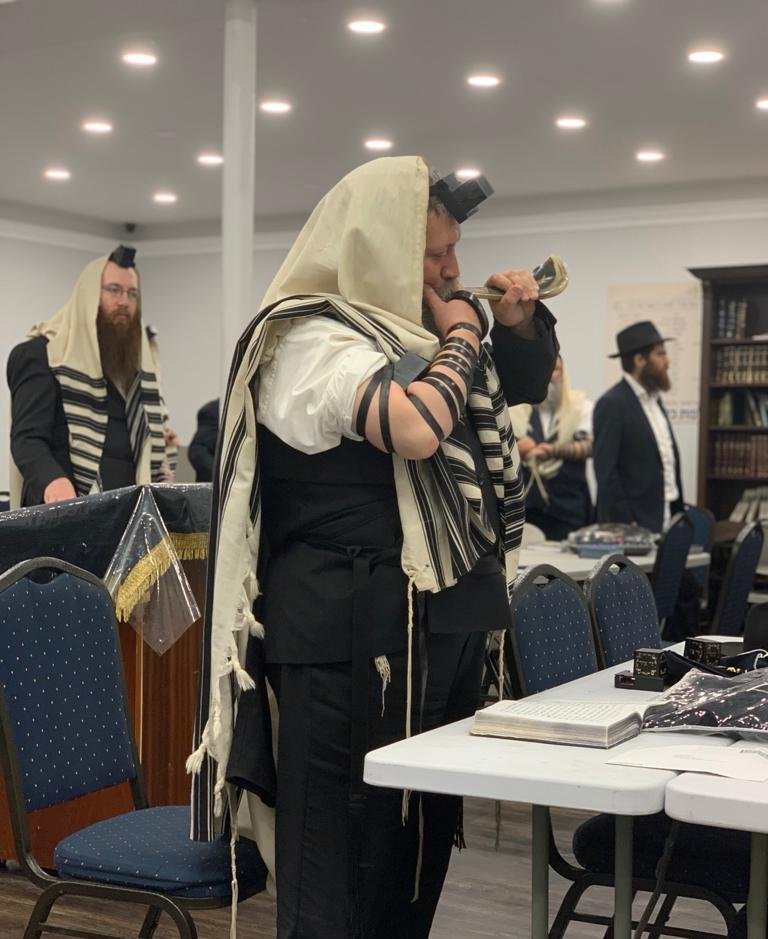
31 minute read
Our Shuls
With the immense growth of the shechuna, a new series ”Our Shuls” was launched on community news service COLlive.com featuring profiles of the local shuls, the driving forces behind them and the communities they created. Here are the most recent shuls featured.
anshei lubavitch
Anshei Lubavitch Shul is a Full Fledged Community If there is one buzzword for the Anshei Lubavitch-Geshem Center, it is ‘unparalleled success’. They have been open for a little over a decade, but its list of accomplishments is astounding. Here are a few: Shul members take a yearly trip to the Kevorim of the Rebbeim, host a weekly father-son Kollel, and house a community daycare. This is all in addition to daily davening and shiurim, community Yom Tov events, and an active Shul sisterhood.
The Shul began as a ‘class Shul’ in 2008. At the time, it was a small shtiebel of mostly single bochurim that were just looking for a shul. As members started marrying and the community grew, they needed to find a larger space. From there the Shul went on a journey, first moving to 397 Troy and then to 589 East New York Avenue. This second move was orchestrated by founder Yossi Levin and the Geshem Center, giving the Shul the name, ”Geshem Center.” At this point, the Shul hired Rabbi Yossi Garelik and ”that is what made the Shul take off,” comments board member Zalman Friedman.
Rabbi Garelik began to urge his members to expand the Shul in all areas to address the needs of the growing community. At his behest, Anshei Lubavitch started the shuls COMMUNITY Kislev 5781 Edition 33 daycare center. The Shul sisterhood, run by heads Brochi Friedman and Rikkel Gopin under the leadership of Mrs. Chani Garelik, began at this time as well. Rabbi Garelik also encouraged members to take on leadership roles, urging congregants to give the daily halacha shiur. The Shul also proved unafraid to try new things, and has seen other Shuls adopt these ideas since. The popular Sunday Kollels, now almost a Crown Heights institution, were started by Anshei Lubavitch. Rabbi Meir New opened the Sunday Kollel, offering a hot breakfast and a children’s program that allows fathers to take their children to Shul and Kollel with them on Sunday mornings. Rabbi New also sponsored and built the Shul library in memory of his fatherin-law, Rabbi Binyomin Katz. After a few years, they moved to their current home at 578 Albany Avenue. They gutted the seedy and dilapidated bar that was there and turned it into a beautiful Shul and Simcha hall. During the move, they decided that they needed to choose a name unique to their Shul. They chose Anshei Lubavitch because they were looking for a name that would set the intention of their Shul. They are a community that ”looks after the physical well being, but our

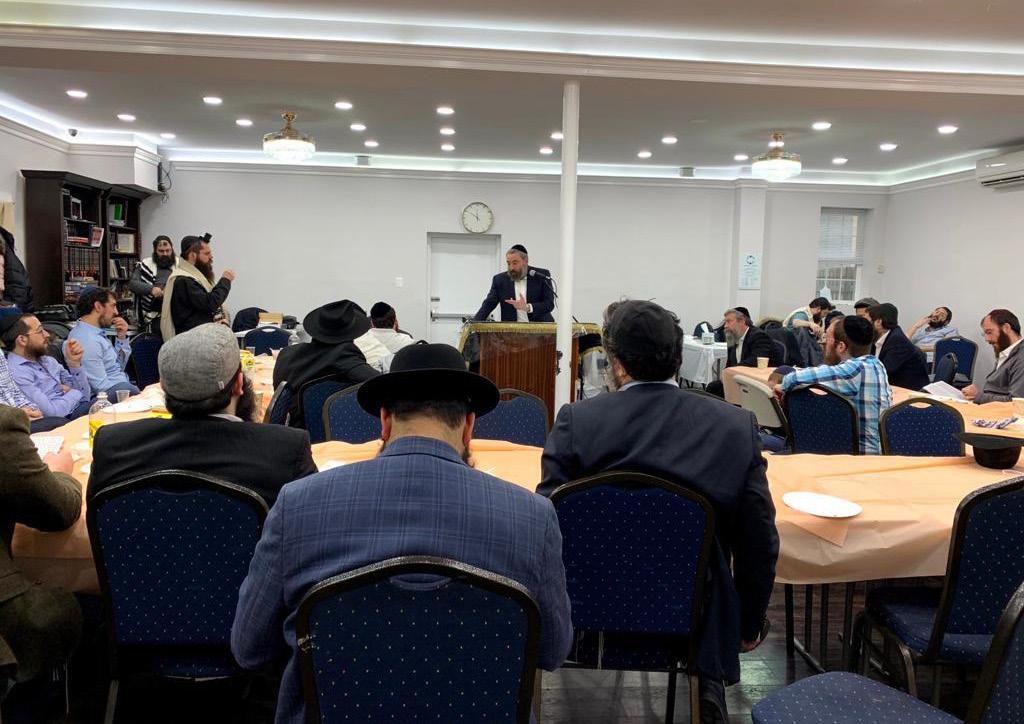
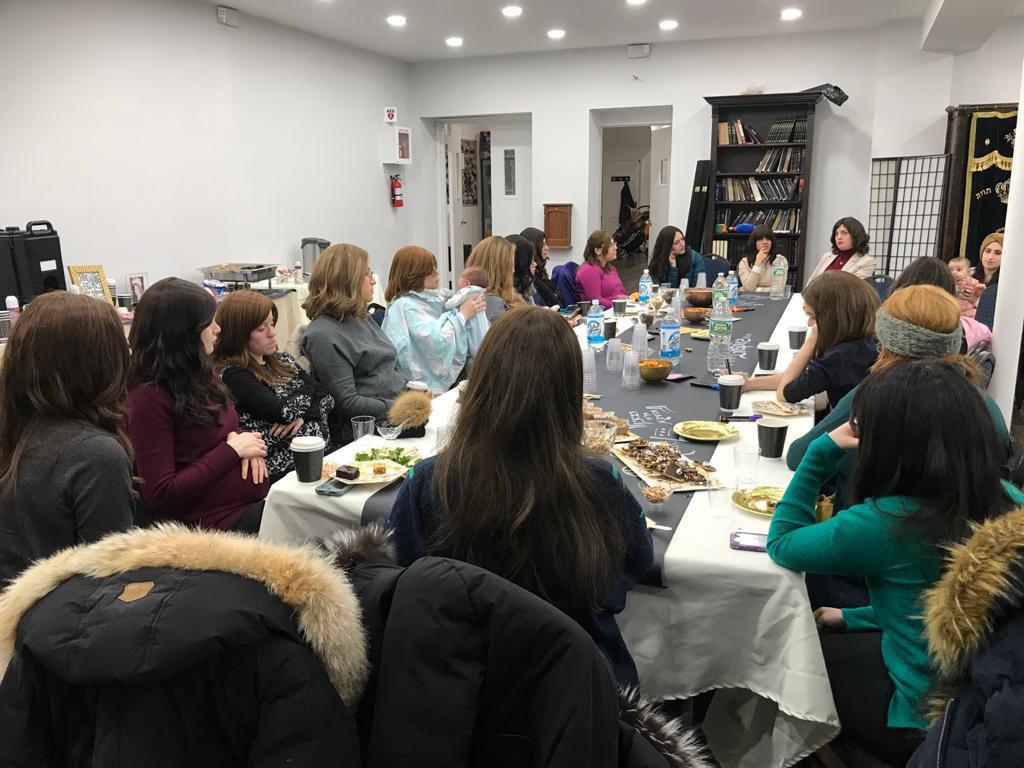
more importantly the spiritual wellbeing, of the members and children.”
Their commitment to this ideal is evident in everything that the Shul has done since. The Shul sisterhood plays a dynamic role in the Shul. Every year they arrange a Shabbaton for the mothers in the community to rest and rejuvenate. With the generous help of local vendors, the sisterhood arranges an annual auction and Melavah Malkah for the entire community. In addition, they also host programs for women every Yom Tov, and a monthly Rosh Chodesh event. Whenever a woman in the community has a child she receives a care package from the sisterhood, and meals delivered for the family for as long as she feels she needs.
The family-based community continues to be of paramount importance. On the encouragement of Rabbi Garelik, the community focuses their events on children and family programming. The over one hundred families that call Anshei Lubavitch home know that they can rely on the Shul to make children’s programming every Shabbos, as well as the Shul’s hugely successful daycare and summer camp. With the pandemic forcing most people to make Yom Tov meals at home, the Shul distributed tens of thousands of dollars worth of food to community members this past Pesach, and again prior to Shavuos. They also delivered weekly care packages with herring and beer for Zoom farbrengens before Shabbos. On the spiritual side, the Shul is in a constant state of growth. For the past two years, they have started a tradition of yearly trips to Nezhin, Kharhov, and Haditch. Community members and speakers deliver shiurim every morning and evening. In the next few months, Anshei Lubavitch hopes to break ground on a men’s mikvah to accommodate their rapidly growing community. In its numerous activities and events, as well as in Rabbi Garelik’s dynamic and inspirational leadership, Anshei Lubavitch continues to set the gold standard for the success that a community can have in Crown Heights.
Bais shmuel
Bais Shmuel – Trailblazing Young Shul of Crown Heights Shuls typically impact the lives of a few, but only a few Shuls have changed the lives of the many. While it may not have a permanent physical location, Bais Shmuel Chabad has successfully touched the lives of many in Crown Heights and beyond. The seeds of Bais Shmuel began in the years after Gimmel Tammuz when the young men of Crown Heights began to face a troubling question. In the past, every Shabbos afternoon would be spent at the Rebbe’s Farbrengen; What now? Rabbi Moshe Pinson was running the children’s program of the Kinus Hashluchim and Kinus Hashluchos. He decided to make a Minyan to help the girls attending the Kinus hear Kriyas HaTorah. The first Shabbos he asked around to get help with a Minyan, and ended up hosting a Minyan for over 100 people. Clearly, he thought, something was here. The Crown Heights community was searching for something. He announced that he would be starting a Minyan in the Shluchim Office, where he worked at the time and whose building on Eastern Parkway was empty during renovations. As a trial week, that first Shabbos was a struggle. Pinson ended up waiting outside, trying to pull people in for a minyan. In a few short weeks, however, the crowd began to grow. Less than a month after opening, they moved into their first home at 824 Eastern Parkway. ”People did not have a personal Shul,” Pinson says. At the time, there were only a handful of Shuls in Crown Heights, nearly all of which were decades old. The notion of starting a shul, and making programming for the Crown Heights community, was
unheard of. That first year they made a Purim party, and the Crown Heights community’s reaction was mixed. ”Nobody did things like that then; we were the Chabad house for Crown Heights,” he says. After that initial event, Bais Shmuel continued to grow, with 125 families as members and a Youth Minyan which attracts over 200 kids each week and includes incentives and trips. They soon began to expand their influence to help the Crown Heights community. They organized a ”Chanukah on Ice” event. They began a free loan society, followed by Maos Chitim funds for Pesach and the other Yomim Tovim. Their events and projects have been, and still are, dedicated to reaching everyone in Crown Heights. The Bais Shmuel Purim Party, now held at Oholei Torah the night of Purim, has become a community institution. Their annual Menorah lighting, held at the Lefrak Skating Rink in Prospect Park, is attended by hundreds. Shul members travel together for Gimmel Tammuz at the Ohel and for Chof Av to
Kazakhstan to mark the yartzeit of Harav Levi Yitzchok Schneerson, the Rebbe’s father. For 16 years, until his passing this year, the Rebbe’s Mazkir Rabbi Leibel Groner led the Shul’s annual Simchas Torah Farbrengen. A recent initiative established in memory of the bochur Shmuel Karnowsky OBM encourages boys and girls to recite Tehillim on Shabbos Mevorchim. The influence of Bais Shmuel is not limited to their programming. Not a Shabbos goes by without young men, heading out on Shlichus, collecting pledges for contributions to their Chabad centers. If there is an event of any kind in
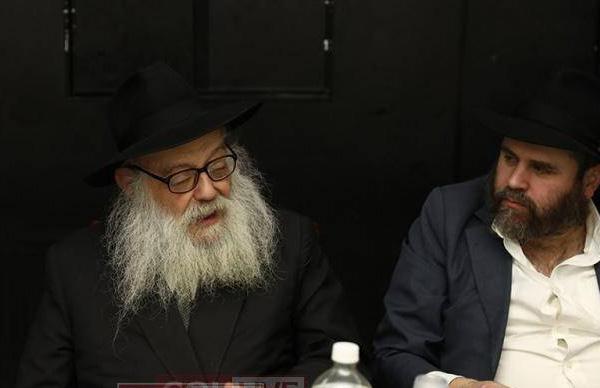

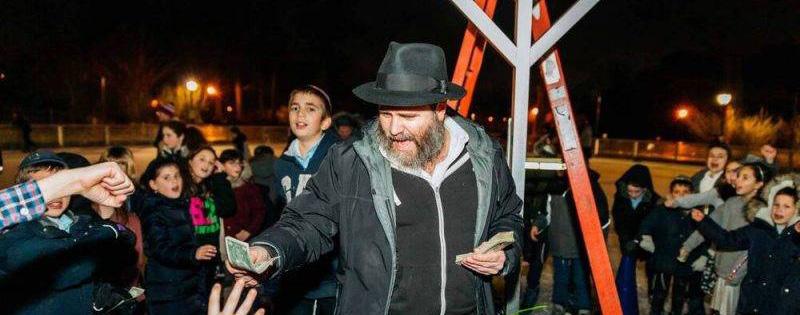
Crown Heights, from the Kinus and Gimmel Tammuz programming to Friendship Circle and the Chidon, the organizers reach out to members of Bais Shmuel. The philanthropy the community is perhaps proudest of, though, is Mikvah Mei Chaya Mushka. Pinson saw that the community had expanded to the point that a new Mikvah was needed, so Bais Shmuel gathered together to make it happen. Members of the Shul were heavily involved in purchasing the building, constructing the beautiful, state-of-the-art Mikvah, and maintaining the Mikvah by fundraising to balance the deficit.
The Mikvah, known as one the most beautiful in the world, is enjoyed by community members and toured by hundreds from around the world every year who learn about the beauty of the Mitzvah. Among the secrets of the Shul’s success is, of course, the people involved. In their early days, the Shul hired Rabbi YY Jacobson as their Rabbi. Rabbi Jacobson’s inimitable poise and intelligence drew a large crowd to hear him speak and his direction led the Shul to unprecedented growth. When Rabbi Jacobson moved to Monsey in 2015, Rabbi Levi Garelik took the position and continues to guide the community until this day. The Shul is led by a group of dedicated board members, Yitzy Kamman, Zalman Stock, Zalman Skoblo and Shaya Rochester with the help of Gabbai Mendy Smetana and assistants Yossi Schapiro, Binyomin Dubroff and Shimmy Shafran. Many of the members of the community have become well-known for their boundless chessed and their contributions to the Jewish community. One former member, entrepreneur and inspirational speaker Dudi Farkash, now the founder of Chabad of Forshay in Monsey, NY, acted as Gabbai for years and helped develop the community from the very beginning. As the first ”young shul” in the neighborhood, Bais Shmuel started a revolution. Nearly 80 new shuls in Crown Heights, as well as an estimated 100 shuls around the world, are modeled after them. ”Bais Shmuel was the trailblazer,” said a founder of another successful Shul in Crown Heights. ”They made it possible for us.” Until today, Pinson gets many calls from young people looking to start Shuls. He sits with them, guiding them through the process of making their own community within Crown Heights. ”Our vision was to build a Chabad House,” he says. Interestingly, while members of the shul have assisted in building and sustaining many institutions, and are known for their activism, they have not secured for themselves a permanent location for their shul.
Pinson, the shul’s founder and president, says he has plans for that. ”We are looking forward to one day building a grand, permanent shul, along with affordable rental housing for young families in the community,” he says.
Hechal baal ‘Hechal Baal Shem Tov’ Shul is For and Run by shem tov Special People Tables are spread out six feet apart, and the congregation is socially distanced. A few faces are covered in masks. The room is spacious, clean and airy; yet the atmosphere is welcoming and warm. A lone voice calls out words of tefillah to the tune of a Miami Boys Choir song. Moments later, a few voices join for a lively Mordechai ben David melody. Voices drift in and out and then someone belts out a few lines of Avraham Fried’s Udevorov Chaim Vkayomim. Everyone joins in. This shul is not your run of the mill shul. It is Hechal Baal Shem Tov, and the congregants are boys and young men with special needs. Today, the chazzan is Boruch Shneur, a thirteen-year-old who has Down Syndrome. He fixes his hat and sings the words of shabbos shmoneh esrei from his siddur.
Rabbi Berel Majeski, the rabbi of the shul, stands nearby. ”Ready to roll?” he calls out. At his cue, the congregants
look into their siddurim, and begin davening mussaf. The Friendship Circle minyan began in September 2012. ”Originally, we gathered for Chanukah parties and Purim parties,” recalls Majeski, who took the reins of Friendship Circle of Crown Heights with his wife, Chanie in 2012. But the Majeskis knew that the boys needed a deeper sense of community. A shul, they realized, would bring the boys together and give them that feeling of belonging. ”A few years ago, we made a minyan for the Friendship
”I love this shul because it feels like family”

Circle boys at Mendy’s Deli on Simchas Torah. We had hakafos in the lobby of the Jewish Children’ Museum.” Boruch Shneur’s mother, Libby, was at the very first hakafos catered directly to the boys of Friendship Circle. ”It was pure sincerity,” she recalls. ”My husband and I just looked at each other and we both felt like the Baal Shem Tov was there dancing with these holy children. There was a certain holiness that you can’t find in another shul.”
Libby and her husband were so touched by the beauty of this minyan, that they decided to dedicate a Sefer Torah. With a Sefer Torah, the Majeskis were now able to form minyanim on their own. After that Tishrei, Friendship Circle minyanim began gathering once a month. Eventually, they began making minyanim bi-monthly, until finally, the boys were gathering for minyanim on a weekly basis. ”Now,” says Majeski, ”we have a minyan every Shabbos, Rosh Hashana, Yom Kippur, and Succos.” In fact, today, the shul has two Sefer Torahs of its own, one of which was donated by the Chaimson family, in honor of their son’s bar mitzvah.
Majeski fondly recalls the first Yom Kippur minyan, which took place in a private house. ”It was shacharis and mussaf,” he says. ”There were fifteen boys and young adults. The kids were totally into it. They sang all the parts of davening and opened the aron. In a regular shul they would be sitting in the back. They wouldn’t feel comfortable singing on the top of their lungs.” Hechal Baal Shem Tov is more than just a shul. It is a place for Friendship Circle boys and girls to celebrate milestones. They have hosted a number of bar mitzvahs, sheva brochos, and other simchas for their members. R’ Chaim Goldman is one of the regulars. ”They recognize anybody and allow anybody to have an aliyah, and sing any song,” says his mother Tzirel Goldman. ”Last shabbos, Chaim had an aliyah for his birthday. This is the shul that will give him an aliyah. The boys have ownership of this minyan.”
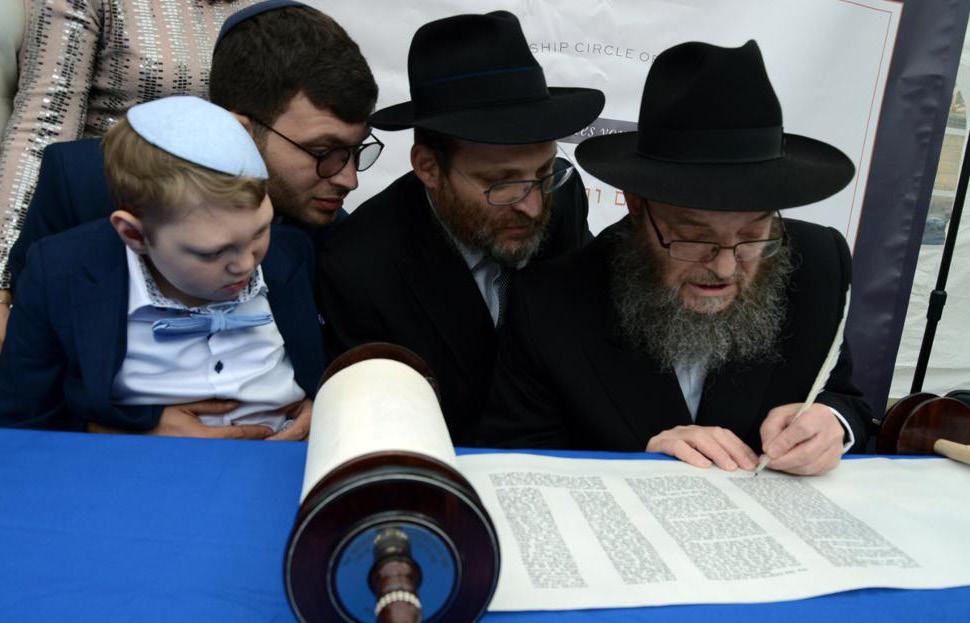
In fact, everyone in the shul has a job. Yossi calls out the page numbers, Leibel serves the cholent, and Dovid Gad clears the table after the kiddush.
”We have our own chazzan and gabbai,” says Majeski. ”The shul is their baby. The older boys see that everyone has their class shul. This is their place. At the kiddush, everyone shares with each other. A dvar Torah, a shout out, or something that happened that week.” At every age, boys with special needs know that they are completely accepted and appreciated at this minyan. ”Boruch Shneur feels like a million dollars when he goes to the shul,” says Libby. ”Not only is he included in the minyan, but he even gets hagbah. When he got hagbah for the first time, I could see his face light up. I could imagine them all smiling down in shamayim when he held the Torah.”
In between aliyahs, Majeski asks the minyan questions about the Parsha. After each aliyah, everyone has a chance to answer. ”No cheating!” Someone calls out. The group feels completely comfortable in this space. If they get an answer wrong, it’s ok. Everyone is accepting of the person beside him. For the boys, Hechal Baal Shem Tov is home. Shmuly, who lives at the local HASC residence during the week, goes home to Philadelphia every few weeks. Recently, Shmuly explained to his parents that he could no longer go home for Shabbos, as that would mean missing his beloved Hechal Baal Shem Tov minyan. It’s not just the boys who love the minyan. Majeski and his ten-year-old son, Mendel, love the minyan just as much as the boys. ”I do a lot of administrative work during the week,” Majeski says, ”but the part of the week I look forward to most is Shabbos with my boys. Short of davening with the Rebbe in 770, there’s no place in the world that has this direct connection with Hashem. There’s no hindrance. It’s going direct.” (Majeski noted that the shul isn’t actively looking for more members outside the special needs community). The boys look forward to shabbos all week long. It is the high point of their week. They all show up on time, no matter what the weather is like. ”They look forward to minyan more than most people I know,” Majeski says. After Shachris is over, I ask a few of the boys what they love most about Hechal Baal Shem Tov.
”The free food!” One boy jokes. The others laugh. Boruch Shneur points to Berel Majeski. ”I love him,” he says. The boys nod in agreement. ”I love this shul because it feels like family,” says a man of around thirty-years-old. ”I like this shul because I can concentrate and say the words right,” says a fifteen-year-old boy. The feeling of warmth for each other and love for Hashem is palpable at Hechal Baal Shem Tov. ”There are pure neshamos davening in this shul,” says Mrs. Goldman. ”This is a very holy place.”
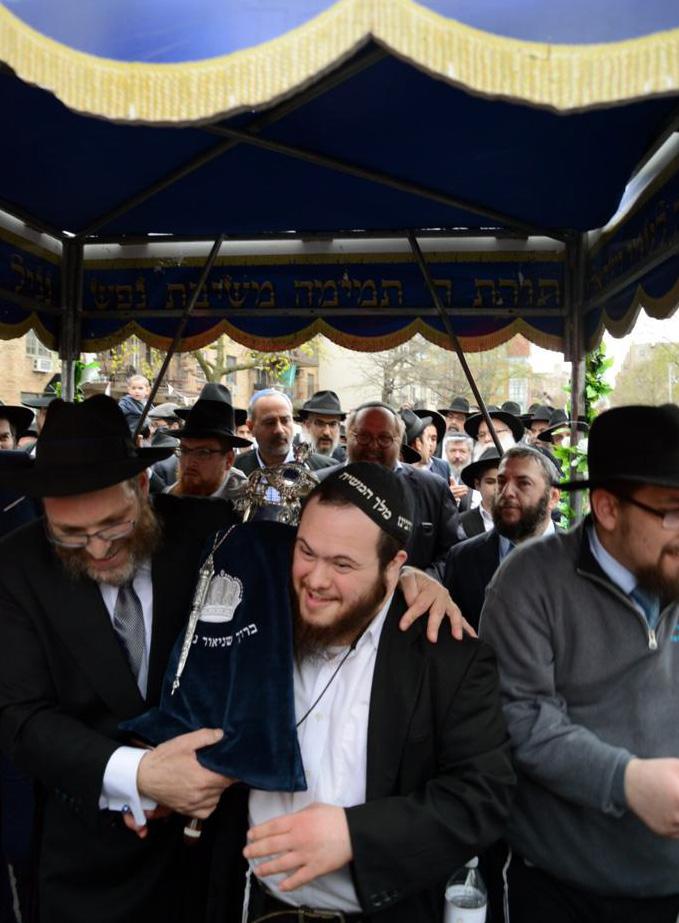
Ohel Nosson
A Sense of Ownership Created and Fuels Ohel Nosson Shul Finding a child saying Tehillim on Shabbos Mevorchim is always an impressive sight. 100 children participating in Shabbos Mevorchim Tehillim while quarantined in their homes during the darkest months of the Covid-19 pandemic sounds like the stuff of miracles. For the members of Ohel Nosson Shul, however, this is just par for the course. Everything done at this shul evinces a strong sense of personal direction. In the beginning, this manifested itself in setting up a small minyan in a classroom on Eastern Parkway. Today, it is a value that is evident in everything this incredible community does. Ohel Nosson began with a group of
bochurim that found themselves gathering in 770 each Shabbos after the main minyan finished. After weeks of spending this time together, the idea of starting their own Shul began to blossom. ”We realized that we were in charge of our own Jewish destiny,” gabbai Avi Webb shares. ”So we said we might as well make it official.” The group was not necessarily from the same class. They were tied together by being in similar stages of life, but more importantly, they shared one significant character trait. They were self-starters; the type of people that did not sit back and let life happen to them. In 2008, they were a group of 20 or so, and together they mapped out all of the things that were needed to make a Shul run; a Sefer Torah, a Ba’al Koreh, the logistics of the Shul, the Kiddush. One by one, each of them volunteered
for one or more of the responsibilities. Among their early supporters was R’ Mordechai Nagel, whose sponsorship included two Sifrei Torah, and the naming of the Shul in loving memory of his father, R’ Nosson Nagel OBM. They quickly outgrew the Eastern Parkway location and started searching for a bigger space. In early 2010, less than two years after
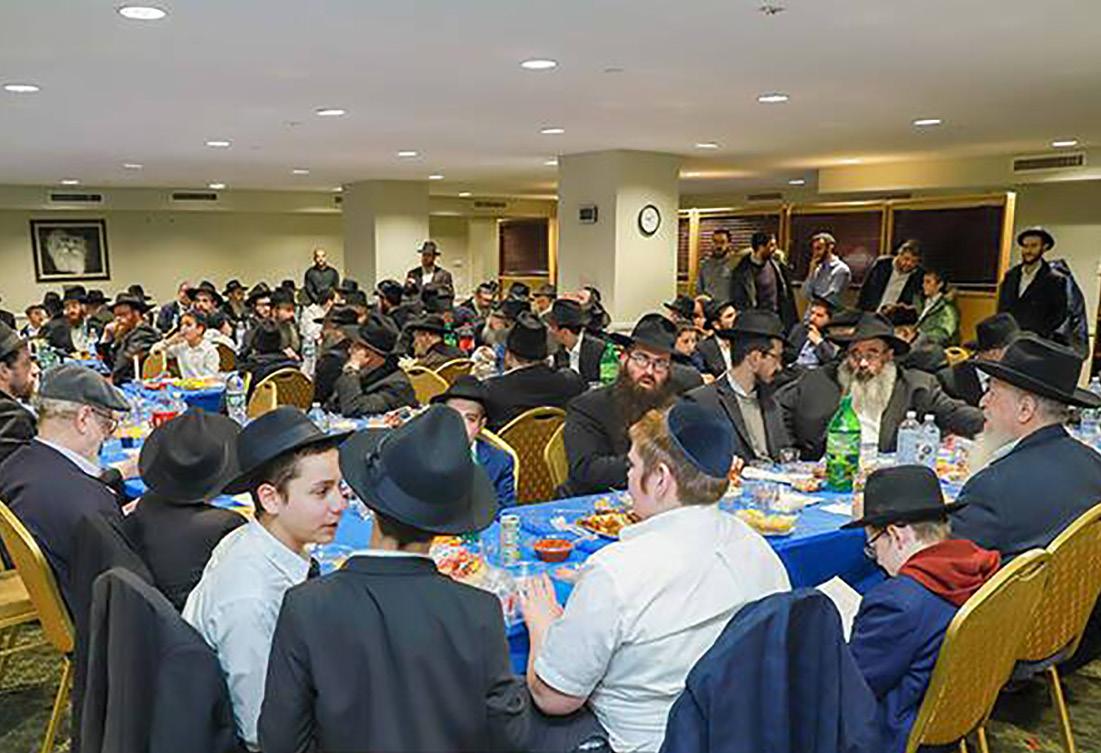
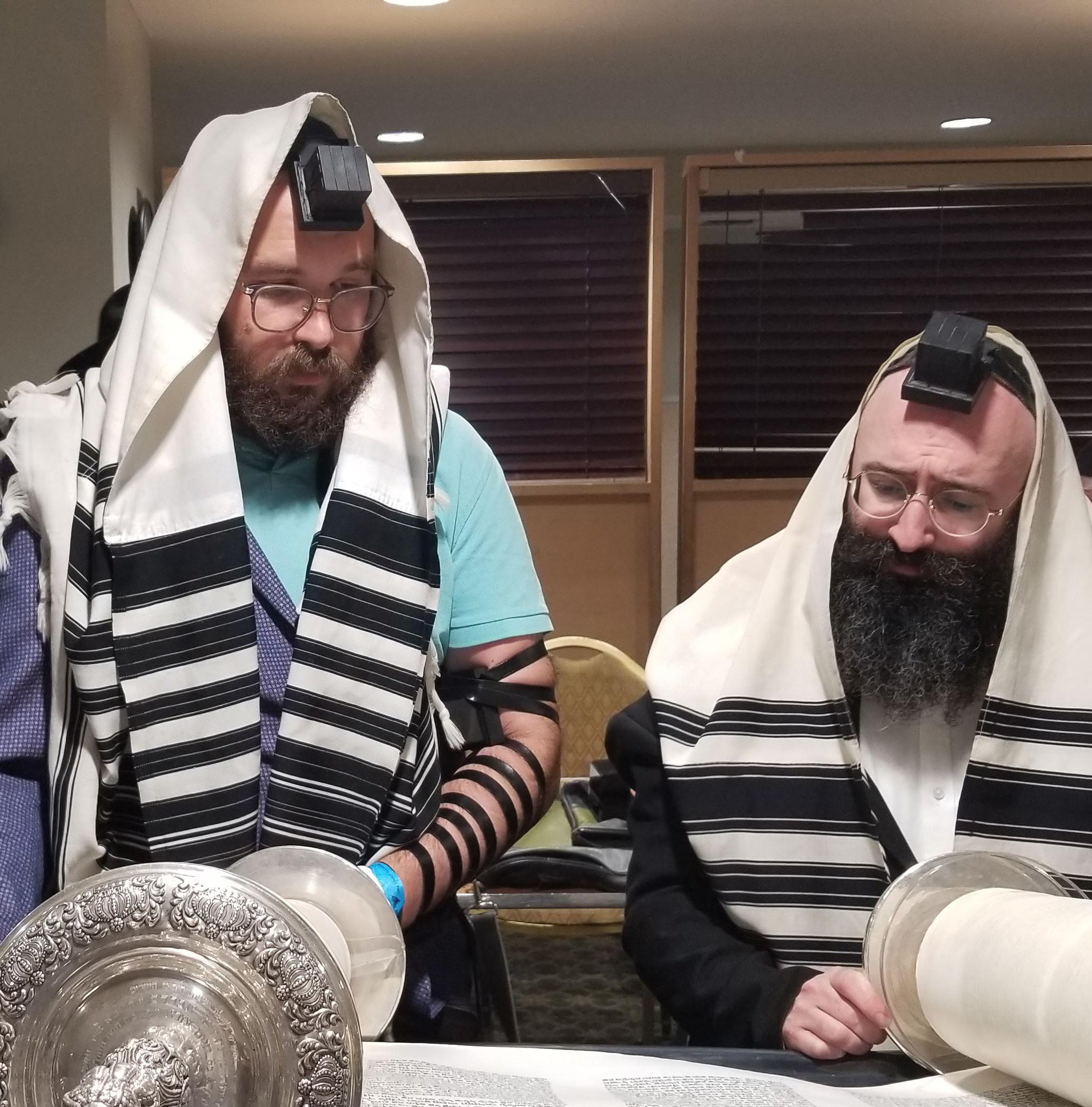
opening, they took the leap in signing a lease at the newly opened Crown Condos. ”This was a bold move for the size we were,” Webb reflects, ”we were still young, most not married. But we knew that we wanted a space for the future.” This philosophy proved prescient, as Ohel Nosson now offers a home to about 100 members on an average Shabbos and a Yom Tov crowd of about 200. People are drawn to the Shul, largely based on the sense of freedom to take ownership of their Yiddishkeit. ”Crown Heights is a good town,” Webb says, ”but there can be a lot of disparity and isolation here. What you want to have – whether a shul or inspiration of any kind – you have to build it yourself. We are welcoming to anyone that wants to be part of that.” As the Shul grows they find that people of all types heed that call. ”In a big haystack you can get lost,” founder and board member Yoni Raskin says. ”We were a group of people trying to find ourselves and to be supportive of each other.” Now, he says, people from all walks of life can find themselves in the Shul.
”There are many tables in the Shul, and every one of them is a safe haven. There were 12 Shevatim in the desert but they were all family. We are all one family.” The sense of ownership exists in every person in the Shul, from the adults to the children. Instead of a speech between Shachris and Musaf, the community enjoys ‘Five Minutes of Fire’. Each week, a community member shares an idea that he finds personally meaningful and relevant. During the week, as well, the community Shiurim are delivered in large part by community members.
The core values of the Shul were brought to the fore with the onset of the Covid-19 pandemic. The community stepped into high gear, delivering care packages to families. The
‘Five Minutes of Fire’, formerly reserved for
Shabbos, was delivered daily over Whatsapp by more than 40 individual members, providing much-needed inspiration to the community at large. The children’s Tehillim were of particular note. The Shul hosts a monthly Shabbos Mevorchim program, during which 60 to 80 children recite Tehillim while enjoying snacks and earning tickets for a raffle. With the Shul shutdown, the monthly snacks were delivered to each home, along with iced coffee, mashke, and herring for adults to Farbreng. The children rose to the challenge, taking part in reciting Tehillim at home during those difficult months. With its reopening, Ohel Nosson is bringing back all of their Shiurim and Shabbos davening. In everything they do, the remarkable congregation of Ohel Nosson continues to blaze a path forward with their fearless drive towards growth.
Kindness to a Fault
In a new biography, the legendary R' Zalman Deitsch's life story is brought to life, here we present an excerpt detailing that even in the face of challenge, he continued to think of others.
By Dovid Zaklikowski
The first decade of the twenty-first century He had dedicated most of his profits to charity. was a dreadful time for the American textile ”When the Rebbe sent me into the business industry. An agreement to end quotas on world,” he used to say, ”I understood that my Chinese imports to the United States flooded the mission in life was to support the institutions and market with cheaper Chinese textiles. The effect on the activities of the Rebbe.” American manufacturers was devastating, ”Free of Quota, China Textiles Flood the U.S.” reported The New York Times on March 10, 2005. ”In the first month . . . imports to the United States from China jumped about 75 per-cent.” ”If I came back early in the night, I slept on the mattress given to From the beginning, he brought a large check to the Rebbe’s office each month, a significant portion of the company’s profits. As the profits increased, so did the contributions. If he did not have the funds available The crisis reached Deitsch me. If I came a to make the monthly Textiles. However, the Deitschs had another little late, someone commitment, he would borrow the money. calamity on their hands: Yosef Deitsch had been diagnosed with a terrible illness. His health had deteriorated to the point that he could not come to the office. was sleeping on my mattress, and I slept on a different mattress or on the The Deitsch siblings and siblings-in-law followed his example and supported many causes, including Tzivos Hashem, Kollel Tiferes Z’keinim Levi Faced with the unraveling of their business and an ill floor.” Yitzchok, Machon Alte in Tzfas, Lubavitcher Yeshivah brother, Zalman encountered Academy in Spring-field, a new financial concern: How Oholei Torah, and Tzeirei would he fulfill his charitable obligations? It had been Agudas Chabad in Israel. They also contributed decades since the Rebbe had advised him to take toward the extension of the Rebbe’s library, the over the family business, a directive he had obeyed Heichel Menachem Library in Borough Park, and despite having set his sights on being a shliach. the building of the ”1414” Lubavitch Yeshivah


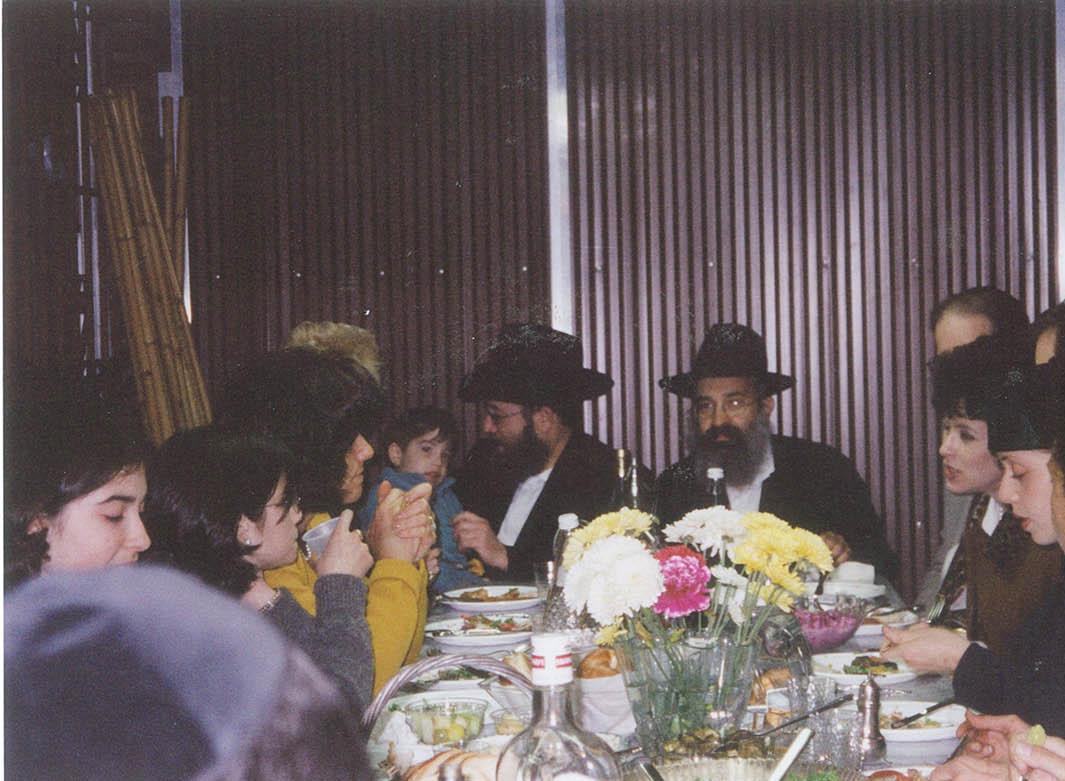
Receives lekach from Rebbe
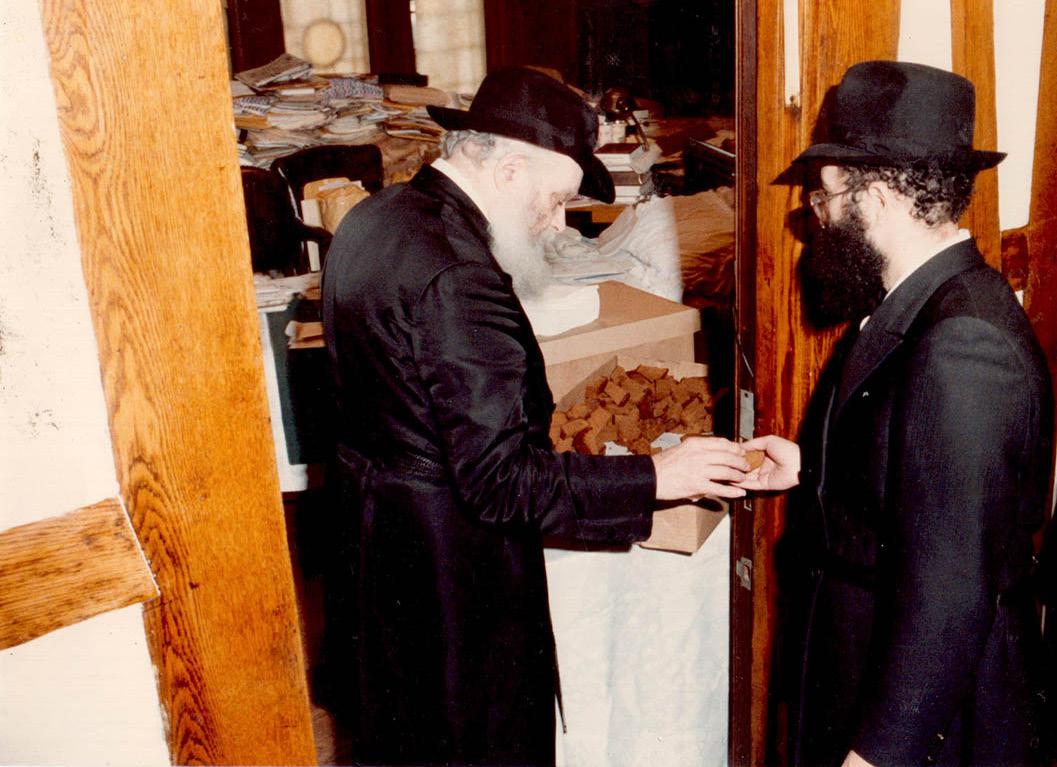
dormitory. At Zalman’s home, when collectors knocked on his door, he always invited them in and inquired about their well-being. His children said that when they saw their father sitting at the table with someone, they could not tell the difference between an old friend and someone who had just come to the door for a donation.
In 2005, however, Zalman was faced with a dilemma. Certain that his tzedakah was a conduit for blessings, it never occurred to him to cut back. He turned to real estate attorney Donald Campbell of Bayonne, New Jersey. Mr. Campbell, or Don, as he liked to be called, had been his lawyer for several large building acquisitions in New Jersey, and the two had become dear friends. The lawyer said they shared a passion for G-d and religion. ”He was very warm, very engaging; [he was] intellectually open to discussion of how we saw our religious beliefs and [our] ability to handle the problems we saw in the world, work, and children,” Mr. Campbell said. ”Our business was secondary to our friendship.” Mr. Campbell knew that charitable causes were very important to his friend—Zalman had convinced him to donate toward several of them. He successfully arranged a loan; the terms, however, were extremely unfavorable to the businessman. The bank wanted, as collateral, not just the building Zalman had offered, but also the rest of his real estate holdings. They also wanted him to submit a solid plan for rebuilding his business to its previous healthy status. Zalman prepared one, which included investing more in real estate, and the bank gave him the loan. He immediately began to distribute tzedakah in the merit of Yosef’s recovery. This time, he decided, he would donate only to organizations that had no family connection. That meant that his fatherin-law’s yeshiva, his children’s Chabad Houses, and any other family member who had an institution would not receive a contribution from these funds. ”There is going to be no personal interest in this tzedakah,” he said to his family. The major benefactors were Crown Heights institutions: The Jewish Children’s Museum, Mivtza Mezuzah, and Hachnosas Orchim (the organization that hosts the guests in Crown Heights for the month of Tishrei), and in Israel, Tzach, the Lubavitch Youth Organization, which heads Chabad’s activities in the country.
Open Door Policy
Zalman and Cyrel Deitsch both came from open, welcoming homes and continued their parents’ legacies on an even grander scale. Guests sometimes stayed for weeks at a time and were given to understand that they were welcome to return. Zalman did his best to make people feel comfortable by inquiring about their families and extended families until he found someone he knew.
One person described how he arrived in Crown Heights for the month of Tishrei 5752 (1991) with no place to stay. ”I decided to take the taxi straight to the Deitsch home,” he said. ”When I arrived, I half asked, half-informed them that I was there for Tishrei. With no questions, Mrs. Deitsch told me where to place my suitcase and a room where I could find a mattress.”
The person said he was not the only one who ”landed” that week at the Deitschs with no prior notice. ”If I came back early in the night, I slept on the mattress given to me. If I came a little late, someone was sleeping on my mattress, and I slept on a different mattress or on the floor.”
There were people sleeping in every corner of the house, he said. The couple never required anything of their guests or asked when they would leave, but supplied them with whatever they needed. ”There was only one thing that we all knew, not that it was requested directly,” the person said. ”When Zalman would come home and he would enter the library, it was our time to give him his peace and quiet so he should be able to learn.”
While Cyrel encouraged her children to bring outof-town guests to their Shabbos meals, Zalman too looked for people in shul who might not have a place to eat. Others, knowing that the Deitsch home was always open, made their way there on Shabbos without an invitation. Everyone around the table was invited to introduce themselves, say a dvar Torah, or begin a nigun. Many of these guests became like family. Cyrel kept in touch with them and invited them to family simches for years afterward.
Each year, thousands of guests would arrive in Crown Heights to celebrate the Tishrei yomim tovim with the Rebbe. It was a huge logistical and financial undertaking to feed them and organize shiurim for all of them. The late Rabbi Moshe Yeruslavsky, who headed Chadrei Torah Ohr in Eretz Yisroel, took on the responsibility, and Zalman, who had a unique appreciation for the mitzvah of hachnosas orchim, was an important supporter of Rab-bi Yeruslavsky’s work. The Deitschs’ Tishrei hachnosas orchim reached a peak during Sukkos. Since they lived next to Kingston Avenue, they built a large sukkah and affixed a sign welcoming anyone in to have a drink and something to eat. Every night of the holiday there was a farbrengen in the sukkah.
Down the street from them was an apartment building where only a few Jewish families lived. The building managers were unaccommodating and for many years did not permit the building of a sukkah on their property. These families were always welcomed by the Deitschs to use their sukkah, and often simply joined the family for their meals.
During one meal on Sukkos, Zalman went into the house to bring more food. When he returned and sat down, one of the guests approached him,
Says a bracha under his nephew's chupah
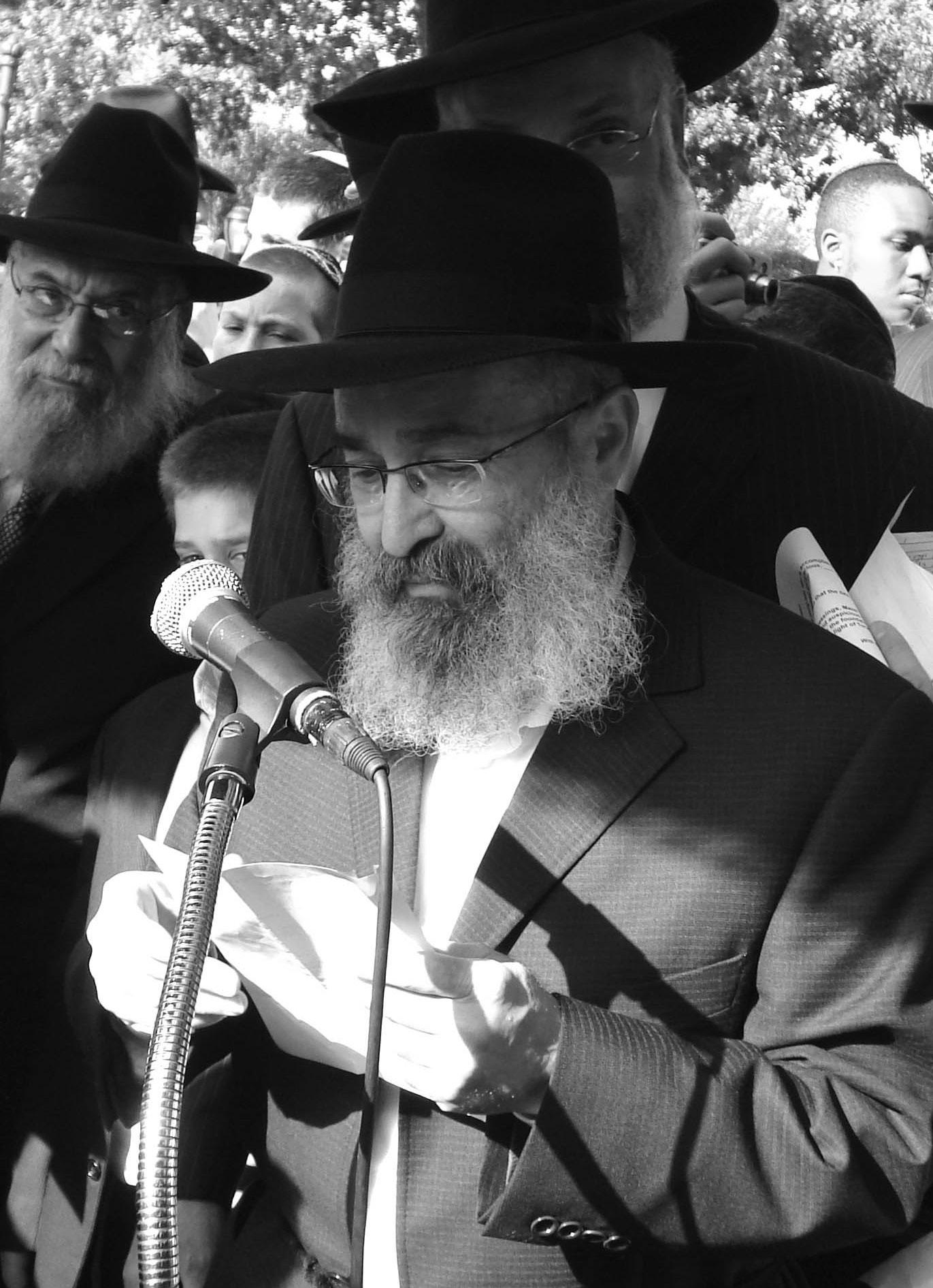
saying, ”Excuse me, but you are sitting in my place.” On another occasion, while Zalman was making sure that everyone had enough food, someone asked him, ”Tell me, until when do you think I could remain here?” not realizing that he was the owner of the sukkah.
Zalman told him not to worry. ”I have been staying here for a long time already, and no one ever asked me to leave.”
Loan Savior
Crestfallen, a local Crown Heights resident was walking home from the bank after being told that his home was about to be foreclosed. He was out of work, and it had been a few months since he had made his last mortgage payment. The bank refused to wait any longer. Zalman spotted the man as he stood waiting for a light to change. ”I knew who he was,” the man recalled. ”But I had never met him, and I doubt he knew who I was.”
Zalman asked him what was bothering him. Unable to restrain himself, the man spilled out his heart. Upon hearing what was going to happen to the family’s home, Zalman immediately made arrangements to extend him a loan. ”The walls of our home, I owe to Zalman Deitsch,” the man said. What the man did not know, said family members, is that in order to give him that loan, Zalman had to take out a loan himself.
Learning in his study
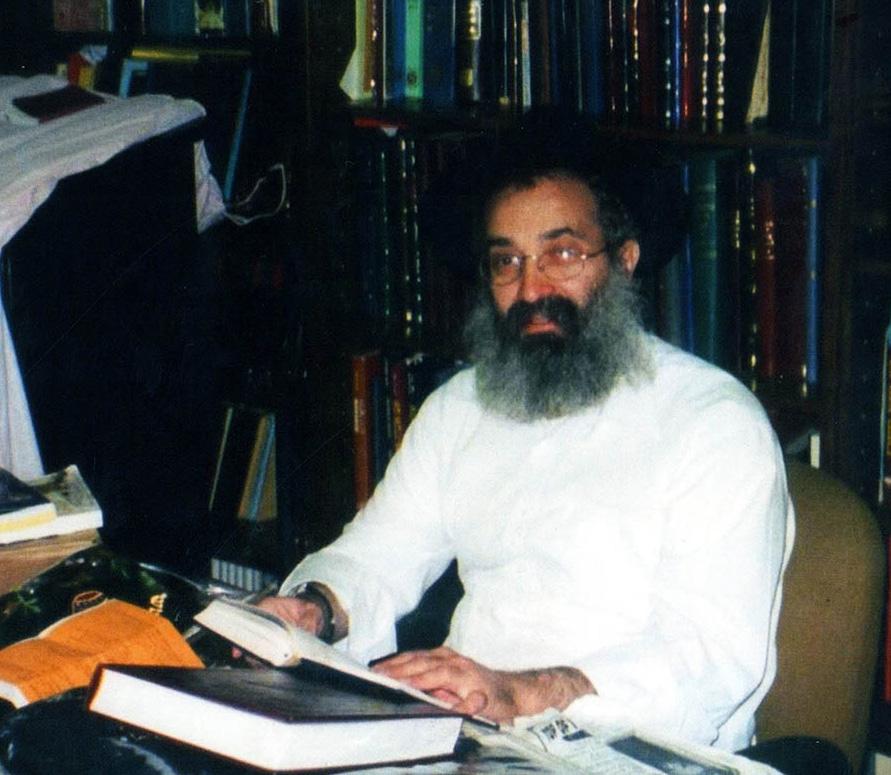
The Gemach
Avrohom Moshe recalled how Zalman decided to open a gemach, a free loan fund, dedicated to the memory of their father, Sholom. ”He would receive many requests for loans,” Avrohom Moshe said. ”And he decided that it needed to be taken to the next level. That was how he established the Keren Sholom fund.” A board was formed, with Avrohom Moshe running the day-to-day operations. The process of granting loans would be transparent, with guarantors and payment plans. In support of this new gemach, the Rebbe sent twenty dollars toward the fund, and they began to give out interest-free loans. ”But Zalman, with his soft heart, would from time to time instruct me to give loans without a guarantor to certain individuals,” Avrohom Moshe said. ”Soon, the Sholom Fund turned from a free loan society into a charity organization. Within a short while, there was nothing left in the fund.” Zalman himself was a guarantor for many loans from other funds. For example, the free loan fund run by the esteemed Chassid Rabbi Zalman Gurary was known to follow strict rules and only accept certain guarantors. Zalman was always accepted, however. In certain cases, when he knew that the person would not be able to pay back the loan, he would pay it back on his own even before the fund tried to collect the debt.
Competitor in the Family
After Yossel Mochkin married Cyrel’s sister Zlati, he decided to go into business—textiles. ”It was the same business as Zalman’s,” he said, ”but on a much smaller scale.” Yet Zalman never saw his brother-in-law as a competitor and helped him in any way he could. ”Zalman was an experienced businessman, and I was a beginner,” Yossel explained. ”He guided me through my blunders, taught me the basics of the business and how to purchase good quality fabrics at a good price.” In the beginning, Yossel was a young, ”wild businessman.” Zalman gently, but firmly, guided him on the correct path so that he would be able to support his family. When he struggled financially, Zalman would bail him out and signed as his guarantor on several loans. Yossel recalled how he used to do mivtzoim in the middle of a workday and learn his daily shiurim. Seeing that his brother-in-law was easily distracted, Zalman told him not to mix his spiritual endeavors with his business. During your free time do mivtzoim and learn, he told him. ”He understood the greatest tzedakah I could do was to bring a check home to support my family,” Yossel said. With Zalman, Yossel knew he could be himself. ”He was my best friend,” he said. ”He knew my talents and my weaknesses. He always respected me and never disparaged my abilities.”
His Needs
Zalman’s consideration for others was legendary. Attending to his own needs, however, was a different story. He didn’t enjoy shopping for himself, and on the few occasions when his wife was able to bring him to the store, he would tell her to buy several of everything that fit him so that he would not have to shop again for a long time. Once, when his shoes wore out, he gave one of them to his children and asked them to bring it to the store and buy another of the same brand while he sat and learned at home.
When it came to the needs of others, however, he was thoughtful in the extreme. One daughter recalled how, when she was moving on shlichus, as the movers were putting the last things on the truck, her father disappeared and returned a few minutes later with coffee and fresh donuts for the movers.
An excerpt from the new biography ”A Chassid, A Businessman: The Story of Zalman Deitsch,” available at Jewish book stores or HasidicArchives.com (use promo code COLlive for free shipping).

